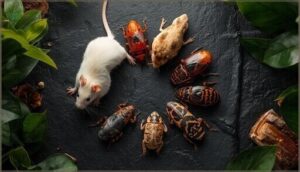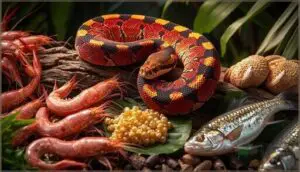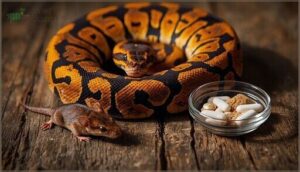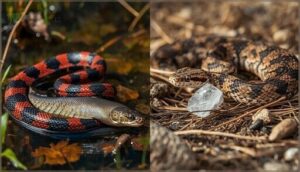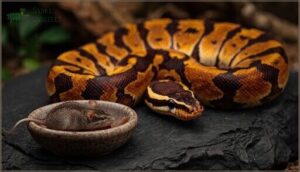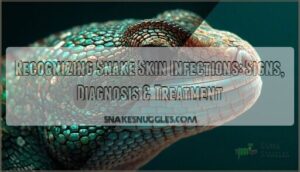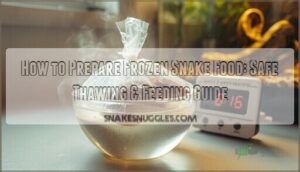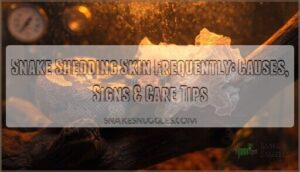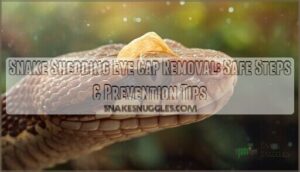This site is supported by our readers. We may earn a commission, at no cost to you, if you purchase through links.

The carotenoids in prey, the balance of essential vitamins, and even the fat content of each meal all influence how brilliantly your snake’s scales reflect light. Getting the nutritional equation right transforms adequate care into superior results, turning a genetically colorful snake into one that truly lives up to its potential.
The right feeding strategy doesn’t just maintain color—it amplifies it, giving you the vivid, eye-catching specimen you envisioned when you first brought your snake home.
Table Of Contents
Key Takeaways
- Your snake’s vibrant reds, yellows, and blacks depend heavily on dietary carotenoids from prey, which deposit in specialized skin cells and reflect specific wavelengths—meaning the nutritional quality of feeder animals directly determines whether your snake displays dull or brilliant coloration.
- Essential nutrients work synergistically to amplify color: vitamin A drives red hues through carotenoid metabolism, vitamin D3 boosts pigment display (with UVB exposure increasing plasma levels by 211% in corn snakes), and trace minerals like zinc and copper serve as enzyme cofactors for melanin synthesis.
- Whole prey outperforms supplemented diets for coloration because specialized intestinal cells process bones and deliver superior mineral bioavailability, while isolated supplements require precision dosing to avoid deficiencies or toxicity that dull pigmentation.
- Common feeding mistakes—including thiamine deficiency from fish-heavy diets, inadequate vitamin D3 causing metabolic issues, and overfeeding creating metabolic stress—affect nearly 28% of captive snakes and can reduce chromatophore density by up to 22%, directly undermining the genetic color potential you’re trying to unlock.
Key Nutrients for Vibrant Snake Coloration
Your snake’s vibrant coloration isn’t just genetics—it’s directly influenced by what you feed them. Specific nutrients work behind the scenes to improve reds, yellows, and overall skin vibrancy, while deficiencies can lead to dull, faded patterns.
Let’s explore the key dietary components that support stunning coloration in captive snakes.
Role of Carotenoids in Enhancing Colors
Carotenoid absorption drives the vibrant yellows, oranges, and reds you’ll see in your snake’s coloration. These pigments, absorbed from prey and deposited in specialized skin cells called xanthophores, reflect specific wavelengths that create those stunning hues.
Dietary sources matter—prey fed carotenoid-rich foods like carrots transfer these pigments naturally. Fossil evidence confirms carotenoids have shaped snake coloration throughout evolutionary history, making supplementation methods a powerful tool for enhancing color intensity today.
Fat content in a snake’s diet can greatly improve carotenoid absorption rates.
Importance of Vitamins A, D3, and C
Vitamins play a powerful role in color regulation. Your snake needs vitamin A to maintain healthy epithelium, aiding those vibrant red hues linked to carotenoid metabolism. Vitamin D3, boosted by UVB exposure, showed corn snakes reaching a 211% increase in plasma levels, enhancing calcium metabolism and pigment display. Vitamin C aids collagen production for skin integrity. Balancing these vitamin supplements prevents deficiency risks while avoiding toxic excess.
Vitamins A, D3, and C work together to regulate your snake’s color intensity, support pigment metabolism, and maintain vibrant skin health
While snakes can survive without it, UVB lighting benefits their health.
Impact of Minerals on Skin and Pigment Health
Mineral balance goes beyond calcium alone, directly influencing chromatophore function. Trace minerals like zinc and copper serve as enzyme cofactors driving melanin synthesis, while selenium deficiency increases oxidative stress that dulls pigmentation. Environmental exposure to pollutants can trigger coloration changes—urban sea snakes show darker morphs correlating with elevated trace element concentrations. Calcium balance stabilizes pigment cell structure, even preserving fossil pigments through mineralization.
- Zinc and copper deficiencies impair melanin production
- Excessive calcium causes metastatic mineralization in skin
- Chromatophores require specific ion channels regulated by mineral availability
Protein Influence on Pigment Patterns
While minerals set the stage, dietary protein abundance drives the show. Snakes fed protein-rich mice for two years show doubled venom protein profiles, indicating substrate-driven plasticity throughout tissues.
PMEL gene expression governs melanosome shape—altering it shifts patterns from blotched to striped. CLCN2 protein effects determine whether chromatophores aggregate into stripes or scatter into speckles.
Amino acid substitutions in pigment receptors fine-tune pattern intensity, while beta-keratin composition sharpens the visual boundaries between colors. Protein quality directly influences coloration changes you’ll observe.
Choosing The Best Prey for Color Enhancement
The prey you choose directly affects your snake’s coloration, from the intensity of reds and yellows to overall skin vibrancy. Different prey items offer varying levels of carotenoids, vitamins, and proteins that fuel pigment production and maintenance.
Let’s break down which prey types deliver the nutrients your snake needs to show its best colors.
Nutritional Value of Common Prey Types
When you’re choosing prey items for your snake, understanding their nutritional value makes all the difference. Rodent nutritional profiles show mice deliver 16% protein with easy digestibility, while rats offer higher fat for larger species.
Feeder insect values reveal Dubia roaches pack 23% protein, and amphibian prey provides enhanced hydration.
Bird nutritional traits highlight chicks’ impressive 76% protein concentration. Prey digestibility varies considerably—mice achieve 97.9% fat absorption compared to chicks’ 87.4%, affecting how your snake utilizes vertebrate prey versus invertebrate prey for best coloration.
Selecting Prey to Boost Red and Yellow Hues
To boost red and yellow pigmentation, you’ll want to target prey with high carotenoid levels. Bioavailability factors and genetic influence determine how effectively your snake deposits these pigments into chromatophores, producing noticeable coloration changes through:
- Marine crustaceans containing astaxanthin for vivid reds
- Carotenoid-rich insects like aphids for yellow enhancement
- Fish with lutein and zeaxanthin for ideal pigmentary roles
- Diverse prey selection ensuring complete nutritional value
Whole Prey Vs. Supplemented Diets
When weighing whole prey against supplements and vitamins, you’ll find dramatic differences in nutrient absorption and snake nutrition. Whole prey delivers enhanced mineral availability through specialized intestinal cells that process bones—absent with supplements—directly impacting skin health and growth outcomes.
While vitamin balance through supplementation remains possible, it demands precision to avoid mineral deficiencies or toxicity, making whole prey’s natural nutritional value the safer choice for vibrant coloration and minimizing dietary risks.
Species-Specific Dietary Strategies
Not every snake needs the same diet to look its best. Species with naturally vibrant patterns, like Eastern Mud Snakes with their red and black scales, require different nutritional strategies than camouflaged hunters or specialized feeders.
Let’s explore how you can tailor feeding approaches based on your snake’s natural diet and coloration needs.
Tailoring Diets for Colorful Species
You can’t simply feed every snake the same way and expect vibrant colors—each species demands its own approach. Color-linked diets in your captive prey variety must mirror wild diet replication to achieve peak coloration.
Kingsnakes, Corn Snakes, and Milk Snakes thrive on rodents, chicks, and quail eggs, while Ball Pythons accept rodents with occasional bird prey.
Enhancing captive coloration hinges on species-specific diets that reflect natural dietary diversity without dietary specialization risks.
Adapting Diets for Specialized Feeders
Specialized feeders like Rainbow Snakes, Mud Snakes, and Queen Snakes need careful captive diet adaptation—roughly 18% of snake species show this level of dietary needs restriction.
You’ll face nutritional deficiencies without proper supplementation strategies, so dust prey with multivitamins and calcium.
When natural prey sourcing proves impossible, offer frozen-thawed fish or alternate whole prey, monitoring closely. Forced feeding remains a last resort for refusal cases.
Customizing Diet for Diverse Eaters
Eastern Kingsnakes, Black Racers, and other diverse eaters thrive on prey variety, which directly strengthens their gut microbiome and nutritional balance. Species-specific diets matter less here; focus on whole prey rotation matching their natural dietary needs for best snake nutrition.
You’ll notice the coloration impact when rotating rodents, birds, lizards, and amphibians—functional analyses show this dietary overlap fosters better carbohydrate and amino acid metabolism.
Feeding Practices That Support Healthy Coloration
Even with the right nutrients in your snake’s diet, how you feed matters just as much as what you feed. The size of prey, timing of meals, and preparation methods all directly influence your snake’s ability to absorb the pigments and nutrients that drive vibrant coloration.
Let’s walk through the practical feeding strategies that keep your snake’s colors at their peak throughout every stage of life.
Determining Ideal Prey Size and Frequency
How do you dial in the perfect meal plan? Prey size guidelines suggest matching the width of your snake’s thickest point, while feeding frequency hinges on age—juveniles thrive on 5–7 day intervals, adults on weekly schedules.
Weight ratio matters too: aim for 10–15% of body weight per meal.
Growth adjustments and shedding impact demand close monitoring, as reduced digestion efficiency during pre-shed periods may warrant slightly smaller prey selection.
Safe Feeding Techniques and Food Preparation
Once you’ve settled on prey size and timing, food presentation becomes your next priority. Training your snake to accept thawed prey reduces injury risk—life-threatening wounds occur in roughly 8% of live-fed constrictors.
Use tongs to mimic movement at 95–100°F, boosting feeding response by 40%.
Always inspect prey for mold or freezer burn, thaw slowly in the fridge to limit bacterial growth, and feed in quiet surroundings to prevent stress-induced refusal.
Seasonal and Life Stage Dietary Adjustments
Your snake’s age and the season dictate feeding frequency and prey size. Juvenile nutrition demands meals twice weekly for proper growth rates, while adults thrive on weekly offerings. Senior care means reduced portions to avoid obesity. Breeding diets require energy-dense prey before ovulation.
Seasonal cycling adjusts naturally:
- Spring and summer trigger weekly feeding frequency in most species.
- Age-specific prey sizing prevents digestive stress across all life stages.
- Adjusting diet for breeding snakes ensures reproductive readiness.
- Winter brumation slows snake feeding cycles, sometimes requiring complete fasting.
Seasonal dietary adjustments maintain vibrant coloration year-round.
Avoiding Common Dietary Mistakes
Even with the best intentions, feeding mistakes can undermine your snake’s coloration and overall health. You might be skipping essential nutrients, offering risky prey items, or missing subtle signs that your current approach isn’t working.
Let’s walk through the most common pitfalls and how to sidestep them so your snake thrives.
Risks of Nutrient Deficiencies and Imbalances
Nutritional deficiencies can quietly sabotage your snake’s health and coloration. Thiamine deficiency from fish-based diets causes neurological damage, while inadequate Vitamin D3 leads to metabolic bone disease and calcium imbalances.
Mineral deficiencies disrupt pigmentation, and protein imbalances reduce chromatophore density, dulling colors by up to 22%.
These dietary imbalances affect nearly 28% of captive snakes, making balanced snake nutrition essential for vibrant skin and long-term wellness.
Unsafe Foods and Prey Items
Toxic insects like fireflies and boxelder bugs pose lethal risks, causing over 40% of feeding-related deaths across 45 snake genera. Hazardous plants, contaminated prey from agricultural areas, and oversized prey create injury risks and toxicology scares.
You’ll face live prey dangers when defensive species fight back or when toxic foods introduce pesticides. Wild-caught items carry environmental toxins, making safe and unsafe foods for snakes a critical distinction.
Monitoring and Adjusting Diet for Optimal Results
How often should you truly check your snake’s progress? Weight change monitoring and skin color observation reveal diet success, while blood nutrient levels confirm nutritional requirements are met.
Track feeding frequencies and behavioral change signals—lethargy often flags deficiencies.
Adjust prey variety based on snake observation, rotating types to address gaps. Your feeding frequency tracking transforms snake diet from guesswork into precision care.
Frequently Asked Questions (FAQs)
Can lighting conditions affect perceived snake coloration?
Think your snake’s colors are set in stone? Light intensity, UV reflectance, and artificial lighting dramatically alter color perception through visual systems. Melanophores shift, and pigments appear brighter or duller, fooling even experienced keepers daily.
Do hydration levels influence skin vibrancy in snakes?
Absolutely. Hydration levels directly affect skin elasticity and shedding success in your healthy snake. Dehydrated individuals show duller coloration and incomplete sheds, while proper fluid intake and humidity effects support vibrant, intact skin and minimize dehydration signs.
How does stress impact color intensity in captivity?
Stress hormone effects directly compromise snake health and wellbeing in captivity. Elevated corticosterone dulls coloration by disrupting chromatophore activity, while environmental stress factors and nutritional stress impact reduce carotenoid absorption, ultimately fading your captive snake’s vibrancy and pattern clarity.
Are there genetic limits to diet-based color enhancement?
Genetic color constraints fundamentally shape snake pigmentation, establishing evolutionary color limits that diet alone can’t override.
Heritable pigment components, like MC1R mutations controlling melanin, define your snake’s color ceiling regardless of nutritional interventions you provide.
Can overfeeding negatively affect natural coloration patterns?
Yes, overfeeding creates metabolic stress effects and nutritional imbalance impact that disrupt pigment cell integrity, leading to coloration pattern disruption.
This diminishes behavioral coloration relevance, ultimately compromising your snake’s best health and natural vibrancy.
Conclusion
The irony? Your snake’s striking coloration isn’t locked in DNA—it’s revealed at feeding time. Every meal either amplifies or mutes those genetic possibilities, making your role more curator than caretaker.
A strategic snake diet for better coloration transforms potential into reality, turning genetic promise into visual impact. You’ve got the knowledge now; what remains is consistency. Feed with intention, adjust with precision, and watch your snake’s colors shift from adequate to remarkable.
- https://www.sciencedirect.com/science/article/pii/S0960982216301208
- https://bewildnc.org/vitamin-c-deficiency-in-snakes
- https://www.thebiodude.com/collections/reptile-vitamins-supplements?srsltid=AfmBOorFJLkoT0p5cW8X33EqyM2HClazNc824u6IJp8gzIcxoCeFm78I
- https://www.nature.com/articles/s41467-024-51927-0
- https://www.researchgate.net/publication/313839895_Effects_of_food_and_thermal_regimes_on_body_condition_indices_and_skin_colouration_in_corn_snakes

